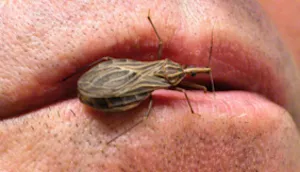
Cloning, localization, and physiological effects of sulfakinin in the kissing bug, Rhodnius prolixus
A scientist’s first 1st-authored paper is among the most important, memorable, and sometimes difficult accomplishments in a career. It is something to be celebrated and for this reason we tip our hat to Ph.D. student Hussain Al-Alkawi (Lange and Orchard Labs) who just published his first paper: “Cloning, localization, and physiological effects of sulfakinin in the kissing bug, Rhodnius prolixus” in Peptides. Sulfakinins, which are satiety peptides found in insects, crustaceans, and arachnids, are homologous to the mammalian cholecystokinin and gastrin family of neuropeptides. The Kissing Bug, Rhodnius prolixus, is the main vector for Chagas disease, which it transmits while feeding on blood. The transcript coding for two sulfakinins was primarily found in the brain region. Sulfated R. prolixus sulfakinin-1 induced hindgut contractions, and injection of the peptide decreased the weight of the blood meal consumed. Hussain’s work provides a genetic basis for understanding how Kissing Bugs know to stop “kissing”.
